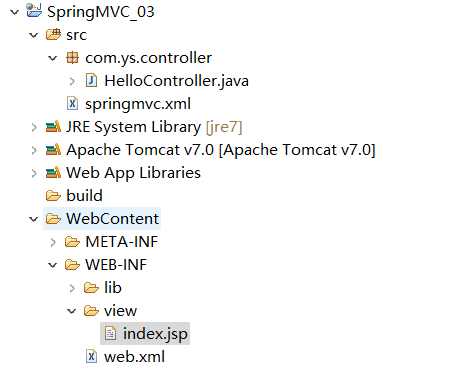SpringMVC详解(三)------基于注解的入门实例
前两篇博客我们讲解了基于XML 的入门实例,以及SpringMVC运行的详细流程。但是我们发现基于 XML 的配置还是比较麻烦的,而且,每个 Handler 类只能有一个方法,在实际开发中肯定是不可能这样来进行开发的。那么这篇博客我们就讲解实际开发中用的最多的基于注解配置的SpringMVC配置。
本篇博客源码下载链接:http://pan.baidu.com/s/1dESLgv3 密码:vkuy
项目结构为:

1、在 web.xml 文件中配置前端处理器
<?xml version="1.0" encoding="UTF-8"?>
<web-app xmlns:xsi="http://www.w3.org/2001/XMLSchema-instance"
xmlns="http://java.sun.com/xml/ns/javaee"
xsi:schemaLocation="http://java.sun.com/xml/ns/javaee
http://java.sun.com/xml/ns/javaee/web-app_3_0.xsd" id="WebApp_ID" version="3.0">
<display-name>SpringMVC_01</display-name>
<!-- 配置前端控制器DispatcherServlet -->
<servlet>
<servlet-name>springmvc</servlet-name>
<servlet-class>org.springframework.web.servlet.DispatcherServlet</servlet-class>
<!--springmvc.xml 是自己创建的SpringMVC全局配置文件,用contextConfigLocation作为参数名来加载
如果不配置 contextConfigLocation,那么默认加载的是/WEB-INF/servlet名称-servlet.xml,在这里也就是 springmvc-servlet.xml
-->
<init-param>
<param-name>contextConfigLocation</param-name>
<param-value>classpath:springmvc.xml</param-value>
</init-param>
</servlet> <servlet-mapping>
<servlet-name>springmvc</servlet-name>
<!--第一种配置:*.do,还可以写*.action等等,表示以.do结尾的或者以.action结尾的URL都由前端控制器DispatcherServlet来解析
第二种配置:/,所有访问的 URL 都由DispatcherServlet来解析,但是这里最好配置静态文件不由DispatcherServlet来解析
错误配置:/*,注意这里是不能这样配置的,应为如果这样写,最后转发到 jsp 页面的时候,仍然会由DispatcherServlet进行解析,
而这时候会找不到对应的Handler,从而报错!!!
-->
<url-pattern>/</url-pattern>
</servlet-mapping>
</web-app>
2、在 springmvc.xml 文件中配置处理器映射器,处理器适配器,视图解析器
<?xml version="1.0" encoding="UTF-8"?>
<beans xmlns="http://www.springframework.org/schema/beans"
xmlns:xsi="http://www.w3.org/2001/XMLSchema-instance"
xmlns:mvc="http://www.springframework.org/schema/mvc"
xmlns:context="http://www.springframework.org/schema/context"
xmlns:aop="http://www.springframework.org/schema/aop"
xmlns:tx="http://www.springframework.org/schema/tx"
xsi:schemaLocation="http://www.springframework.org/schema/beans
http://www.springframework.org/schema/beans/spring-beans-4.2.xsd
http://www.springframework.org/schema/mvc
http://www.springframework.org/schema/mvc/spring-mvc-4.2.xsd
http://www.springframework.org/schema/context
http://www.springframework.org/schema/context/spring-context.xsd
http://www.springframework.org/schema/aop
http://www.springframework.org/schema/aop/spring-aop-4.2.xsd
http://www.springframework.org/schema/tx
http://www.springframework.org/schema/tx/spring-tx.xsd">
<!--注解处理器映射器 -->
<bean class="org.springframework.web.servlet.mvc.method.annotation.RequestMappingHandlerMapping"></bean> <!--注解处理器适配器 -->
<bean class="org.springframework.web.servlet.mvc.method.annotation.RequestMappingHandlerAdapter"></bean> <!--使用mvc:annotation-driven可以代替上面的映射器和适配器
这里面会默认加载很多参数绑定方法,比如json转换解析器就默认加载,所以优先使用下面的配置
-->
<!-- <mvc:annotation-driven></mvc:annotation-driven> --> <!--单个配置Handler -->
<!-- <bean class="com.ys.controller.HelloController"></bean> --> <!--批量配置Handler,指定扫描的包全称 -->
<context:component-scan base-package="com.ys.controller"></context:component-scan> <!--配置视图解析器 -->
<bean class="org.springframework.web.servlet.view.InternalResourceViewResolver">
<!-- 返回视图页面的前缀 -->
<property name="prefix" value="/WEB-INF/view/"></property>
<!-- 返回页面的后缀 -->
<property name="suffix" value=".jsp"></property>
</bean>
</beans>
3、编写 Handler
package com.ys.controller; import org.springframework.stereotype.Controller;
import org.springframework.web.bind.annotation.RequestMapping;
import org.springframework.web.servlet.ModelAndView; //使用@Controller注解表示这个类是一个Handler
@Controller
public class HelloController { //@RequestMapping注解括号里面的表示访问的URL
@RequestMapping("hello")
public ModelAndView hello(){
ModelAndView modelView = new ModelAndView();
//类似于 request.setAttribute()
modelView.addObject("name","张三");
//配置返回的视图名,由于我们在springmvc.xml中配置了前缀和后缀,这里直接写视图名就好
modelView.setViewName("index");
//modelView.setViewName("/WEB-INF/view/index.jsp");
return modelView;
} }
注意@Controller注解和@RequestMapping注解的用法
4、编写 视图 index.jsp
<%@ page language="java" contentType="text/html; charset=UTF-8"
pageEncoding="UTF-8"%>
<!DOCTYPE html PUBLIC "-//W3C//DTD HTML 4.01 Transitional//EN" "http://www.w3.org/TR/html4/loose.dtd">
<html>
<head>
<meta http-equiv="Content-Type" content="text/html; charset=UTF-8">
<title>Insert title here</title>
</head>
<body>
hello:${name}
</body>
</html>
5、在浏览器中输入:http://localhost:8080/SpringMVC_03/hello

SpringMVC详解(三)------基于注解的入门实例的更多相关文章
- 转载 SpringMVC详解(三)------基于注解的入门实例
目录 1.在 web.xml 文件中配置前端处理器 2.在 springmvc.xml 文件中配置处理器映射器,处理器适配器,视图解析器 3.编写 Handler 4.编写 视图 index.jsp ...
- Mybatis(二)基于注解的入门实例
前言 上一篇简单的介绍了Mybatis的概念和基于XML来实现数据库的CRUD,这篇给大家实现基于注解的CRUD. 一.初始搭建 在基于注解当中前四步和上一篇基于XML是一样的,分别是: 1)创建数据 ...
- SpringMVC详解一、@RequestMapping注解与Controller接收参数
SpringMVC详解一.@RequestMapping注解与Controller接收参数 https://blog.csdn.net/mxcsdn/article/details/80719258 ...
- 第5章—构建Spring Web应用程序—SpringMVC详解
SpringMVC详解 5.1.跟踪Springmvc的请求 SpringMVC的核心流程如下: 具体步骤: 第一步:发起请求到前端控制器(DispatcherServlet) 第二步:前端控制器请求 ...
- Comet技术详解:基于HTTP长连接的Web端实时通信技术
前言 一般来说,Web端即时通讯技术因受限于浏览器的设计限制,一直以来实现起来并不容易,主流的Web端即时通讯方案大致有4种:传统Ajax短轮询.Comet技术.WebSocket技术.SSE(Ser ...
- SpringMVC详解------参数绑定
SpringMVC详解------参数绑定 转载于:https://blog.csdn.net/swebin/article/details/92795422 目录 1.SpringMVC 参数绑定 ...
- ViewPager 详解(一)---基本入门
前言:这两天研究研究ViewPager滚动功能,现在很多的app都有用到这个功能,我们的大虾米也有这个模块.要研究就彻底的研究研究,我从不满足于一个功能只是简单的应用,要学就学的彻底,所以我打算将Vi ...
- Android 之窗口小部件详解(三) 部分转载
原文地址:http://blog.csdn.net/iefreer/article/details/4626274. (一) 应用程序窗口小部件App Widgets 应用程序窗口小部件(Widget ...
- WebSocket安卓客户端实现详解(三)–服务端主动通知
WebSocket安卓客户端实现详解(三)–服务端主动通知 本篇依旧是接着上一篇继续扩展,还没看过之前博客的小伙伴,这里附上前几篇地址 WebSocket安卓客户端实现详解(一)–连接建立与重连 We ...
随机推荐
- Java 实现FTP上传和下载
1. 目前网上开源的FTP Client主要有JFTP.FTP4.edtFtpjJ和Apache.FTPClient. 2. jftp地址:http://www.jmethods.com/ 3. ed ...
- 一个简单的时间轴demo
一个时间轴的组成 使用一个块级元素包裹内容,并未块级元素设置边框 定义圆形或者菱形等元素标签,子元素设置偏移或者定位元素将图标定位到边框上 使其中的内容不溢出,自动换行,内容自动撑高 英文自动换行:w ...
- 关于Actionbar的那些事
咱们来说说有趣的Actionbar吧 Actionbar这个控件是3.0以后添加的,Google在13年的时候把它加入了v7包,现在第三方的Actionbarserlock基本没什么用了, 要兼容2. ...
- 分享网上搜到的Oracle中对判定条件where 1=1的正解
今天在网上找到了Oracle中对判定条件where 1=1的正解,粘贴出来和大家分享下 1=1 是永恒成立的,意思无条件的,也就是说在SQL语句里有没有这个1=1都可以. 这个1=1常用于应用程序根据 ...
- nyoj_323:Drainage Ditches(网络流入门)
题目链接 网络流入门@_@,此处本人用的刘汝佳的Dinic模板 #include<bits/stdc++.h> using namespace std; const int INF = 0 ...
- python之总体理解
作为脚本,python具备了弱类型语言的灵活性,便捷性.这在日常的开发使用中能够大幅度的减轻开发人员的编码负担,开发者也能够将精力集中在程序的逻辑管理和总体构架设计上.一般而言,随着经验的积累,开发人 ...
- ABP从入门到精通(1):aspnet-zero-core项目启动及各项目源码说明
一.ABP的简单介绍 ABP是"ASP.NET Boilerplate Project (ASP.NET样板项目)"的简称. ASP.NET Boilerplate是一个用最佳实践 ...
- (转)java中对集合对象list的几种循环访问总结
Java集合的Stack.Queue.Map的遍历 在集合操作中,常常离不开对集合的遍历,对集合遍历一般来说一个foreach就搞定了,但是,对于Stack.Queue.Map类型的遍历,还是有一 ...
- python2.7 + selenium3.4.3浏览器的选择
大家都知道,selenium2对火狐浏览器兼容性比较好,和谷歌和IE相比,好处是无需安装相应的driver.exe来支持启动浏览器,但是缺点是最高支持火狐47版本. 现在selenium3出来了,是不 ...
- FaceRank,最有趣的 TensorFlow 入门实战项目
FaceRank,最有趣的 TensorFlow 入门实战项目 TensorFlow 从观望到入门! https://github.com/fendouai/FaceRank 最有趣? 机器学习是不是 ...
